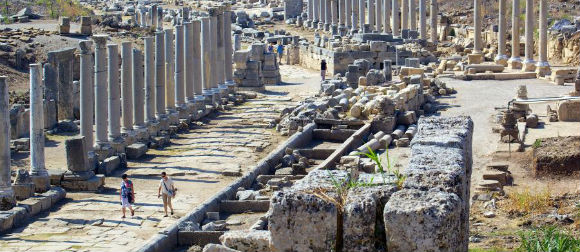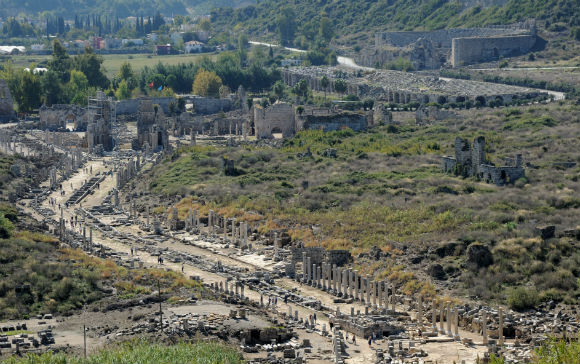The most impressive ruins of the Pamphylian coast are at Perge, at about 15 km east of Antalya. Perge was originally founded by the Hittites around 1500 BC. and was known as Parha. It was a successful trading centre near the Aksu (ancient Kestros or Cestrus) river when Alexander the Great arrived in 333 BC. He was welcomed in by the inhabitants and used Perge as base for his Anatolian campaigns. Alexander was followed by the Seleucids under whom the city prospered and Perge’s most celebrated inhabitant, the mathematician Apollonius from Perge lived and worked. Apollonius was a pupil of Archimedes and wrote a series of eight books on geometry. In 188 BC Perge became part of the Roman Empire during which the city flourished. Most of the surviving buildings date from this period.In 46 AD St. Paul started his journey in Perge (biblical Perga) and preached his first sermon here. Perge gradually declined during the Byzantine period, as the Aksu river silted, but remained inhabited until Selçuk times after which it became abandoned.
A visit to Perge starts by entering the archeological site through the Roman Gate, built during the reign of Septimius Severus (193-211 AD). Proceeding through the gate, to the right is the Agora or market place. This structure of 75 x 75 m dates back from the 2nd century AD. The center courtyard and shops were surrounded by a wide stoa, a covered walkway. The floor of the stoa and shops was made of colored mosaics. The agora was not only the centre of Perge’s trade, but was also a place for meetings as well as a forum for political, social, and philosophical discussions. The next building is the Hellenistic city gate that dates back to the 3rd century BC. This is certainly the most imposing building of the city and was cleverly designed to protect the city with its twin towers and its horseshoe-shaped courtyard at the back. It is thought that the towers had three floors and were crowned by a conical roof. In the year 121 AD, the horseshoe-shaped courtyard was rededesigned as a courtyard of honor. Behind the courtyard stood a triple arch. Around the arch there are about dozen inscriptions connected with Plancia Magna who lived in the 2nd century AD. She was the daughter of the governor, a priestess of Artemis Pergaia (Diana) and a benefactress to the city. Plancia Magna had the arch decorated with the statues of the emperors and their relatives.
After passing through the Hellenistic Gate and courtyard, one enters a broad, marble-paved double-colonnaded street measuring 300 meters in length that extends from the main gate to the acropolis. The street is 20 m wide and is divided in two by a 2 meter wide water channel running down the middle. At the end of the colonnaded street is the Nymphaeum, a triumphal fountain from where a stream flowed down into the water channel. The nymphaeum or nymphaion is an ornamental semicircular structure and dates from the reign of Emperor Hadrian (130-150 AD). A statue of a river god Kestros was located in the center of this huge fountain. Behind the nymphaeum is the acropolis with some remains of the Byzantine period. To the west of the nymphaeum are the remains of a palaestra dating from 50 AD and dedicated to the Emperor Cladius (41-54 AD).
Returning back to the entrance, there are the excavated Roman baths located southwest to the agora. Out of the site proper, is the horsehsoe-shaped stadium, the largest in Asia Minor, measuring 234 m by 34 m. The stadium had a seating capacity of 12,000 people supported by massive barrel-vaulted constructions. Just beyond the site entrance is also the theatre, which is of the Greco-Roman type and could seat 15,000 people. Unfortunately, it is for some time under reconstruction and unfortunately closed to visitors.
Perge,



Superb huge ruins where you are allowed to walk the entire grounds at your leisure. Our tour guide was knowledgeable and I recommend using one.
This first class visit was organised by First Choice/Thomson. First stop was Perge, what an unbelievable site, breathtaking to think how advanced the Grecians/Romans were in 300bc!!.
After Perge we travelled to Aspendos to view what is one of the best preserved Amphitheatres in the world truly amazing. The First Choice guide was very knowledgeable and helpful. The excursion was…
We spent a lovely, sunny, and warm afternoon going round the great ruins of the city of Perga. Most satisfying exploration of a Greek-Roman ancient city. It was great to visit the site in November as there were only a few people coming at the same time and the weather was just perfect for such an activity.
We visited as part of the Thomas Cook trip combined with the waterfalls and amphitheater.
Our guide Abraham was proper old school guide and knowledgeable historian with a love of social history. He spoke about myths legends and then archaeological truth and discovery. Some of the other tours had flasher louder younger guides who seemed to speed round the site….
Would love to rteturn and spend a whole day there. An interesting and memorable visit
Perge is easy to reach from Antalya & the surrounding resorts like Lara beach. Plenty to see & the trip is much enhanced by having a good guide to explain what you are seeing. The towers are unusual & the baths are impressive, but the whole site full of interest. Perge is famous by the fact that when Saint Paul…
A large site which has been extensively excavated. There is an enormous stadium which has collapsed like a pack of cards and a theatre ( no current access) which looks impressive from outside. If you visit this site, you must also go to the Antalya Archaeological Museum where many of the statues recovered from the site are displayed. Entrance admission…
We didn't take a tour but, with help from the tourist office in Antalya, went to the little town of Aksu by the inexpensive local bus (check number and stopping-place with tourist office – route could change and create confusion – but buses run about every 10 mins. and the journey to Aksu takes about half an hour) and then…
From the many granite columns that are left standing today, one can easily imagine what a magnificent city Perge once used to be. One can still see the theatre, stadium and gate towers leading to a very long street where a statue of a water god can be seen at the end. Ancient chariot ruts can still be seen on…
Many, many things to see in Perge. Watching the transition from Greek to Roman city. Long columned streets, the agora, the gates, it's all here.